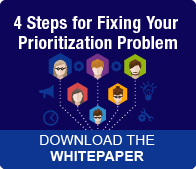We often encounter organizations that half-jokingly claim they’ve never met a project or imitative they didn’t like. But these same companies also struggle when trying to resource and deliver all of their initiatives fast enough and within budget. Sound familiar? We are betting it does. 
The perennial prioritization issue seems to affect every organization. Everywhere we look there are too many projects chasing too few resources. In addition, there is no clear line of sight to the total number of projects that are actually in play, where resources are being spent, or whether the initiatives are really directly tied to the strategic agenda. So how do you fix it?
Focus Down to Speed Up
As change management consultants, we are often in a position to work with senior-level executives on establishing an improved climate for change implementation through better decision-making. In this role, we tell leaders all the time that they need to "focus down to speed up." What we mean by this is that to go faster, you have to actually slow down by having fewer initiatives on the organizational change plate at the same time. It may sound counter-intuitive, but slowing down ultimately results in greater speed.
But the reality may be that there are very legitimate strategic reasons why initiatives can’t be eliminated. If this is the case, it is often possible to sequence the activities so that you are better positioned for success.
To that end, we’ve compiled the following four step process to assist organizations that are looking to evaluate their change portfolio and set consistent decision-making criteria. This may include project portfolio management software or not.
-
Know Everything Your Organization is Working On
The best starting place is to consolidate all projects into a single master schedule to provide the visibility required to make informed decisions on capacity to implement and resource capability for existing and new projects. It is imperative to include projects that are in the pipeline as well as current initiatives.
-
Categorize by Project Type
Once you have a full list of projects, the next step is to categorize your projects by type. Remember, depending on your strategic priorities, some categories are going to be more important than others.
-
Prioritize by Applying Consistent Selection Criteria
One of the major mistakes organizations make is that they do not use consistent standards to determine project prioritization. Each organization has to have its own set of criteria to match up project requests against. These criteria can then be weighted to ensure mandatory/regulatory projects will be automatically included, while projects with questionable business value can be eliminated.
-
Implement
Once you have created your prioritized list, the real work of implementation begins! This is the time to ensure you have a realistic “Implementation Plan” and not just an “Installation Plan” for all your projects.
A Caution About Using Project Portfolio Management (PPM) Tools
There are many Project Portfolio Management (PPM) tools available, and they can be extremely useful in improving decision-making processes. PPM technology can provide the missing big picture into all the programs and projects going on in the "nooks and crannies" of your organization. But take caution, software may be part of the answer, but technology alone is not going to be enough. Portfolio Management is a people and cultural change issue as well, and requires a people-focused solution! 
Remember, when you introduce a new prioritization process, it’s a change, and it’s subject to the same barriers and risks you face on any other strategic change. There may be a lack of alignment on the scope of the change, insufficient Sponsorship, ineffective communication, and no reinforcement for following the new processes. If you don't manage the human side of the PPM tool implementation you will end up installing the new technology but you won’t get full benefit realization from using it.
Ensuring you have a realistic implementation plan (rather than an installation plan) and a structured change management approach such as IMA’s proprietary Accelerating Implementation Methodology (AIM) will help provide the structure, processes, and tools needed to support better decision-making and the ability to do a much better job of sequencing implementations over time.
Speed comes from focus. So focus down to speed up. {Tweet This}


